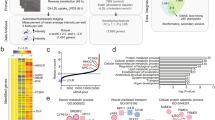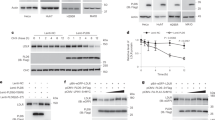Abstract
CHOLESTEROL and its oxysterol congeners are important constitu-ents of cell membranes and function as intermediates in several crucial biosynthetic pathways. These compounds autoregulate their metabolic fate by end-product repression and activation of downstream catabolism1. Although end-product repression by oxysterols is relatively well understood2, the mechanism by which these compounds act as positive transcription signalling molecules is unknown. Here we identify a specific group of endogenous oxysterols that activate transcription through the nuclear receptor LXRα. Transactivation of LXRα by oxysterols occurs at concentrations at which these compounds exist in vivo. The most potent activators also serve as intermediary substrates in the rate-limiting steps of three important metabolic pathways: steroid hormone biosynthesis, bile acid synthesis, and conversion of lanosterol to cholesterol. Our results demonstrate the existence of a nuclear receptor signalling pathway for oxysterols and suggest that LXRα may be important as a sensor of cholesterol metabolites.
This is a preview of subscription content, access via your institution
Access options
Subscribe to this journal
Receive 51 print issues and online access
$199.00 per year
only $3.90 per issue
Buy this article
- Purchase on Springer Link
- Instant access to full article PDF
Prices may be subject to local taxes which are calculated during checkout
Similar content being viewed by others
References
Russell, D. W. Cardiovasc. Drugs Ther. 6, 103–110 (1992).
Wang, X., Sato, R., Brown, M. S., Hua, X. & Goldstein, J. L. Cell 77, 53–62 (1994).
Willy, P. J. et al. Genes Dev. 9, 1033–1045 (1995).
Heyman, R. A. et al. Cell 68, 397–406 (1992).
Harmon, M. A., Boehm, M. F., Heyman, R. A. & Mangelsdorf, D. J. Proc. Natl Acad. Sci. USA 92, 6157–6160 (1995).
Byskov, A. G. et al. Nature 374, 559–562 (1995).
Kandutsch, A. A., Chen, H. W. & Heiniger, H.-J. Science 201, 498–501 (1978).
Dhar, A. K., Teng, J. I. & Smith, L. L. J. Neurochem. 21, 51–60 (1973).
Javitt, N. B., Kob, E., Burstein, S., Cohen, B. & Kutscher, J. J. Biol. Chem. 256, 12644–12646 (1981).
Dixon, R., Furutachi, T. & Lieberman, S. Biochem. Biophys. Res. Commun. 40, 161–165 (1970).
Forman, B. M. et al. Cell 81, 687–693 (1995).
Forman, B. M. et al. Cell 83, 803–812 (1995).
Kliewer, S. A. et al. Cell 83, 813–819 (1995).
Song, C., Kokontis, J. M., Hiipakka, R. A. & Liao, S. Proc. Natl Acad. Sci. USA 91, 10809–10813 (1994).
Ikekawa, N. in Sterols and Bile Acids (eds Danielsson, H. & Sjövall, J.) 199–230 (Elsevier/North Holland Biomedical, Amsterdam, 1985).
Yao, T. -P., Segraves, W. A., Oro, A. E., McKeown, M. & Evans, R. M. Cell 71, 63–72 (1992).
Mangelsdorf, D. J. et al. Cell 83, 835–839 (1995).
Kliewer, S. A., Umesono, K., Noonan, D. J., Heyman, R. A. & Evans, R. M. Nature 358, 771–774 (1992).
Leng, X., Tsai, S. Y., O'Malley, B. W. & Tsai, M. J. J. Steroid Biochem. Mol. Biol. 46, 643–661 (1993).
Hörlein, A. J. et al. Nature 377, 397–404 (1995).
Chen, J. D. & Evans, R. M. Nature 377, 454–457 (1995).
Oñate, S. A., Tsai, S. Y., Tsai, M. J. & O'Malley, B. W. Science 270, 1354–1357 (1995).
Dolle, R. E., Schmidt, S. J., Erhard, K. F. & Kruse, L. J. Am. Chem. Soc. 111, 278–284 (1989).
Morisaki, M., Sato, S. & Ikekawa, N. Chem. Pharmacol. Bull. 25, 2576–2583 (1977).
Mangelsdorf, D. J., Ong, E. S., Dyck, J. A. & Evans, R. M. Nature 345, 224–229 (1990).
Giguère, V., Ong, E. S., Segui, P. & Evans, R. M. Nature 330, 624–629 (1987).
Weinberger, C. et al. Nature 324, 641–646 (1986).
Baker, A. R. et al. Proc. Natl Acad. Sci. USA 85, 3294–3298 (1988).
Issemann, I. & Green, S. Nature 347, 645–650 (1990).
Green, S. et al. Nature 320, 134–139 (1986).
Hollenberg, S. M. et al. Nature 318, 635–641 (1985).
Author information
Authors and Affiliations
Rights and permissions
About this article
Cite this article
Janowski, B., Willy, P., Devi, T. et al. An oxysterol signalling pathway mediated by the nuclear receptor LXRα. Nature 383, 728–731 (1996). https://doi.org/10.1038/383728a0
Received:
Accepted:
Issue Date:
DOI: https://doi.org/10.1038/383728a0
This article is cited by
-
Assessment of Two Potential Probiotic Strains As Anti-Obesity Supplements Under High-Fat Feeding Conditions
Probiotics and Antimicrobial Proteins (2023)
-
The TICE Pathway: Mechanisms and Potential Clinical Applications
Current Atherosclerosis Reports (2023)
-
T-cell Cholesterol Accumulation, Aging, and Atherosclerosis
Current Atherosclerosis Reports (2023)
-
Methionine regulates self-renewal, pluripotency, and cell death of GIC through cholesterol—rRNA axis
BMC Cancer (2022)
-
Human adaptation to high altitude: a review of convergence between genomic and proteomic signatures
Human Genomics (2022)
Comments
By submitting a comment you agree to abide by our Terms and Community Guidelines. If you find something abusive or that does not comply with our terms or guidelines please flag it as inappropriate.



